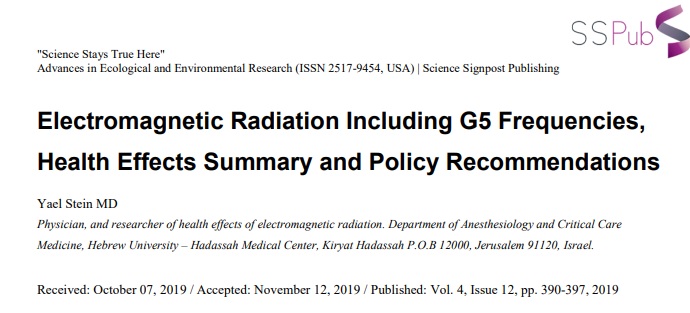
Abstract:
Introduction: 5G millimeter wave technology offers advantages: “smart” homes, “smart” cities and autonomic automobiles. A rise of at least 30-100% in exposure to electromagnetic radiation (EMR) from antennas in the public space near citizens’ homes is expected, and higher exposure levels inside homes from millions of devices communicating with antennas (“Internet of Things”). Scientists have declared current exposure levels not relevant to protect against health effects. A rise in exposure raises the risk of an extreme rise in incidence of adverse health effects including electrohypersensitivity. Susceptible members of the public such as pregnant women, babies and children have a right to be protected from chronic exposure of public source, in their private homes, against their will. Following implementation of 5G technology in the public space, some electrohypersensitive individuals would be forced to leave their homes and become refugees.
Methodology: Presented at the CEST 2019 Electromagnetic Radiation Workshop, this is a summary of some of the adverse health effects reported following exposure to electromagnetic radiation, and of health effects of exposure to 5G frequencies (millimeter waves) reported in animal studies. No study that proves safety of 5G frequencies for public use exists.
Reported effects: Reported health effects, similar to symptoms reported in Occupational Medicine studies in the 1950-60’s, include: headache, hematologic problems, fertility problems, decline in libido and neural effects –named “Microwave Sickness”. In newer studies this same syndrome is called Electrohypersensitivity. EMR has been categorized as a possible human carcinogen by IARC. Experiments conducted in former USSR on animals exposed to non-thermal levels of millimeter waves for only 15 minutes a day demonstrated detectable changes in both the central and peripheral nervous system, changes in permeability of blood vessels, changes in the reflex response of the nervous system (stronger response from a lower trigger) and changes in the hematopoietic and lymphatic systems. Studies from the Hebrew University in Jerusalem and from Japan demonstrate that human sweat ducts respond to millimeter waves and concentrate the energy inside the skin, contradicting the assumption that G5 frequencies cannot penetrate the skin.
Conclusions: There is no known method to measure 5G frequencies outside the laboratory. The decision to authorize 5G frequencies by the US FCC relied only on thermal 1996 guidelines and did not take non-thermal biological effects or public health precautionary measures into account. Extensive public exposure keeping with thermal allowable levels is expected to have adverse health effects and is therefore unsafe. Safer alternatives do exist: broad band internet via fiber-optic infrastructure, including for wired “smart” meters. Electromagnetic radiation is an environmental pollutant. There is a need to evaluate the potential health effects and the environmental effects of both the new and the existing technology as well as the economic burden on the Health system of a rise in health effects including electrohypersensitivity. In accordance with the precautionary principle, it is the responsibility of those who wish to implement G5 technology, to prove that it is safe for public use.
